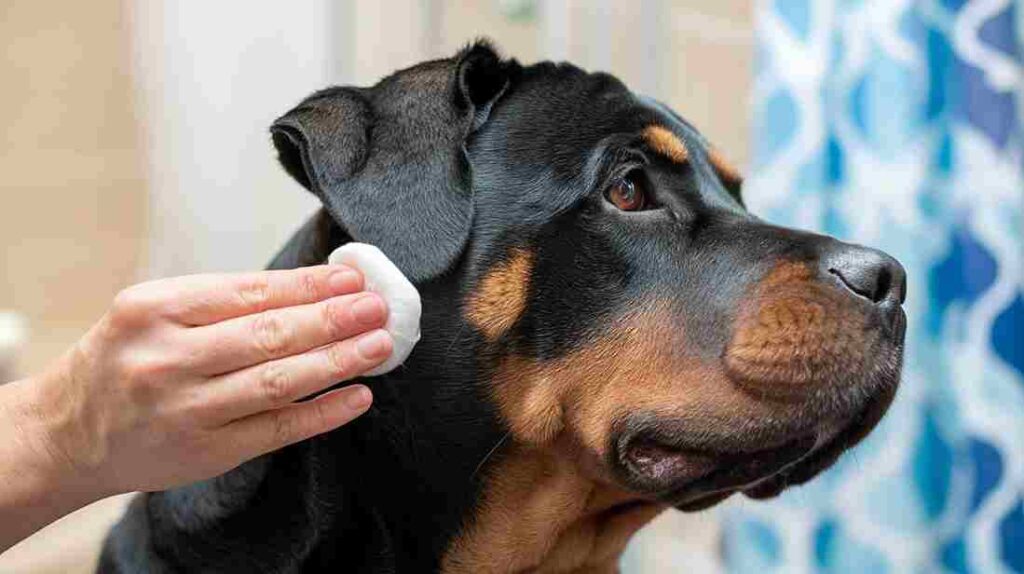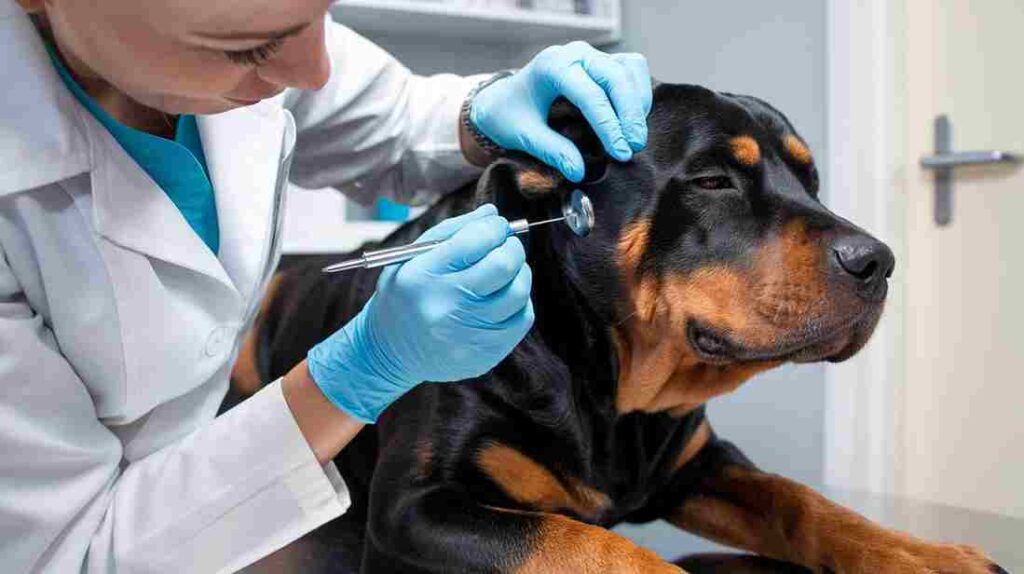-
Not recognized by official breed standards
-
Purely cosmetic procedure
-
No proven health benefits
-
Can cause unnecessary pain and complications
-
May affect a dog's ability to communicate through ear movements
Hey there, fellow dog lovers! Let’s talk about those adorable Rottweilers and a somewhat controversial topic: ear cropping. You might have seen pictures of dogs with those pointy, upright ears, and wondered if that’s something Rottweilers get done. Well, the answer is… not usually!
So, why do people crop dog’s ears in the first place? Well, let’s dive in and explore the history, the controversy, and what you need to know to make the best decisions for your furry friend.
What Are Clipped Ears in Rottweilers?

So, you might be wondering, “What’s the deal with those pointy ears on some dogs?” Well, that’s what we call “clipped ears” or “cropped ears.” It’s actually a surgery where a vet removes parts of a dog’s floppy ears to make them stand up straight.
Now, here’s the thing about Rottweilers: you won’t usually see them with clipped ears. Why? Because those floppy ears are totally natural for them! It’s how they’re supposed to look.
Think of it like this: Rottweilers are born with those adorable, expressive floppy ears. It’s part of their breed standard, kind of like how Golden Retrievers have that gorgeous golden fur.
Clipping those ears is like… well, it’s like giving a Golden Retriever a purple mohawk! It’s just not natural, and it doesn’t really benefit the dog in any way.
The History and Controversy
Historical Context
So, you might be wondering, why did people ever start cropping dog’s ears in the first place? Well, it mostly goes back to the days when dogs had tough jobs, like guarding livestock or, unfortunately, even fighting.
People thought that cropping those ears would prevent injuries during work or fights. Some even believed it would make dogs hear better or prevent ear infections. But guess what? Modern science has proven those ideas wrong!
Turns out, those floppy ears are actually pretty awesome just the way they are. They don’t need any “fixing” to do their job.

Modern Perspectives
Thankfully, times are changing! The veterinary community is starting to realize that ear cropping is just not cool. It’s like, “Hey, those floppy ears are awesome just the way they are!”
The American Veterinary Medical Association (AVMA), a leading authority in veterinary medicine, has publicly condemned the practice of ear cropping, citing ethical concerns and the lack of any medical benefit. You tell ’em, AVMA!

And guess what? Many vets are now refusing to crop dogs’ ears altogether. They’re like, “Nope, not doing that. It’s not good for the dog.” High five to those compassionate vets!
Plus, there’s growing evidence that cropping a dog’s ears can mess with their ability to communicate with other dogs. It’s like taking away their ability to use body language. Not fair!
And let’s not forget about the big picture: animal welfare. More and more people are realizing that putting dogs through unnecessary surgeries just for looks is not okay. We love our furry friends, and we want them to be happy and healthy!
Medical Implications

Okay, so we’ve talked about the history and the controversy, but let’s get down to the nitty-gritty: what are the actual medical implications of ear cropping?
Risks of Ear Cropping:
- Surgical complications: Any surgery comes with risks, and ear cropping is no exception. Things can go wrong during the procedure itself, leading to complications. This article from VCA Animal Hospitals, a leading network of veterinary clinics, details the potential complications associated with ear cropping, including infection, scarring, and nerve damage, emphasizing the risks involved in this purely cosmetic procedure.
- Post-operative infections: Those newly cropped ears are vulnerable to infections, which can be painful and require more vet visits and medications.
- Chronic pain: Even after the ears heal, some dogs experience chronic pain in their ears due to the altered nerve endings. That’s just not fair to our furry friends!
- Behavioral changes: Some dogs might become more head shy or sensitive around their ears after cropping.
- Communication difficulties: Dogs use their ears to communicate with each other, and cropping can interfere with that. It’s like taking away their ability to use body language! A compelling study published in the journal ‘PLOS ONE’ explores the ways in which ear cropping can disrupt a dog’s ability to communicate with both humans and other dogs, potentially leading to misunderstandings and behavioral issues.
Natural Ear Benefits:
Now, let’s talk about why those natural floppy ears are actually pretty awesome:
- Better protection against debris: Those floppy ears act like little shields, helping to keep dirt and debris out of the ear canal.
- Enhanced social communication: Dogs “talk” to each other with their ears! Those floppy ears help them express a whole range of emotions.
- Natural temperature regulation: Believe it or not, those ears help regulate a dog’s body temperature.
- Improved directional hearing: Floppy ears can actually help dogs pinpoint the source of sounds more accurately.
- Better smell perception through ear movement: This is a cool one! Studies have shown that dogs can actually use their ear movements to help them sniff things out better.
So, as you can see, those natural ears are pretty amazing! They’re not just cute, they’re functional too!
Legal Status Worldwide
So, where does the law stand on ear cropping? It’s actually a bit of a mixed bag around the world.
Countries Where Ear Cropping is Banned:
- United Kingdom: Those Brits love their dogs, and they’ve officially banned ear cropping! Good on ya, UK!
- Australia: No ear cropping Down Under! Australia has also banned this practice.
- Most European Union countries, including Germany: Yep, even Germany, where many of these breeds originated, has said “no” to ear cropping.
- Canada (some provinces): Some provinces in Canada have also jumped on the ban wagon.
- New Zealand: New Zealanders are all about animal welfare, and they’ve banned ear cropping too.
US Regulations:
- Legal but increasingly restricted: In the US, it’s a bit more complicated. Ear cropping is still legal in many places, but things are starting to change.
- Many states require licensed veterinarians: Many states now require that only licensed vets can perform ear cropping, which helps to ensure it’s done properly (if it has to be done at all).
- Growing number of municipalities ban the practice: And some cities and towns are even taking things a step further and banning ear cropping altogether. Way to go!
- Tail docking still common but facing scrutiny: Tail docking is another practice that’s facing more and more scrutiny. While it’s still more common than ear cropping, especially for Rottweilers in the US, many people are starting to question whether it’s really necessary.
It’s encouraging to see that so many places are taking a stand against these unnecessary and potentially harmful procedures. Hopefully, more and more countries will follow suit and put animal welfare first!
Alternative: Ear Taping Guide
So, maybe you’re thinking, “Okay, no ear cropping, got it. But what if I’m not a fan of those ‘fly-away’ ears?”
No worries, there’s a much gentler option: ear taping! This is a great way to help those floppy ears form a nice fold without any cutting or surgery. It’s like giving those ears a little guidance, kind of like braces for your puppy’s ears!
Here’s the step-by-step guide to ear taping like a pro:
Gather Your Supplies:
- High-quality duct tape (you want the good stuff that will stay put!)
- Sharp scissors
- A clean cloth for wiping those ears
Prepare the Tape:
- Cut a 4-inch piece of duct tape.
- Create notches on each side:
- 1-2 inches on one side
- 2.5 inches on the other side (this helps the tape conform to the ear’s shape)
- Fold the tape onto itself carefully.
Time to Tape Those Ears!
- Gently fold your puppy’s ear inside out.
- Apply the smaller sticky side of the tape at the highest point possible on the ear.
- Wrap the tape around the ear until it sticks to itself.
- Gently pop the ear back out.
- Check to make sure there’s a nice crease forming.
Keep an Eye on Things:
- Leave the tape on for about a week.
- After a week, check the ear position and the crease.
- If needed, reapply the tape for another week.
- Always keep an eye out for any irritation or discomfort. If your puppy seems bothered by the tape, take it off and consult your vet.
Ear taping is a great way to help those ears look their best without resorting to any painful or unnecessary procedures. And remember, every Rottweiler is beautiful, regardless of how their ears fold!
Natural Ear Care Guide
Alright, so we’ve covered why those floppy ears are awesome and how to avoid any unnecessary snipping. Now, let’s talk about how to keep those ears healthy and happy!

Regular Maintenance:
- Weekly cleaning: Just like we brush our teeth, our Rottweilers need regular ear cleaning to prevent any gunk from building up. Aim for a weekly cleaning session, but you might need to do it more often if your vet recommends it.
- Proper cleaning technique:
- Use veterinary-approved cleaners. Ask your vet for recommendations if you’re not sure what to use.
- Gently wipe the inside of the ear with cotton balls. No harsh scrubbing!
- Avoid Q-tips. Those can actually push debris further into the ear and cause damage.
- Keep those ears dry after bathing. Moisture can be a breeding ground for bacteria and yeast.
Ear Trouble? Watch Out for These Signs:
- Excessive scratching: If your Rottie is constantly pawing at their ears, something might be up.
- Head shaking: Is your dog shaking their head like they’re trying to get water out of their ears? That could be a sign of irritation or infection.
- Redness or swelling: Take a peek inside those ears. If you see any redness or swelling, it’s time for a vet visit.
- Unusual odor: Healthy ears shouldn’t have a strong or unpleasant odor.
- Discharge: Any discharge from the ears, especially if it’s yellow, green, or bloody, is a cause for concern.
- Visible discomfort: If your dog seems to be in pain or is sensitive around their ears, it’s time to see the vet.
By following these simple tips and keeping an eye out for any signs of trouble, you can help keep those floppy ears healthy and happy for years to come!
Treating Ear Problems
Okay, so even with the best care, sometimes those floppy ears can run into trouble. But don’t worry, we’ve got you covered!
What Could Be Going On?
Ear problems can have a few different culprits:
- Bacterial infections: These are common in adult dogs and can cause all sorts of discomfort.
- Yeast infections: Yep, just like us, dogs can get yeast infections in their ears.
- Ear mites: Those pesky little critters are especially common in puppies and can cause a lot of itching and irritation.
- Allergies: Just like humans, dogs can have allergies that affect their ears.
- Foreign objects: Sometimes things get stuck in those ears, like grass seeds or even tiny toys!

Time for a Vet Visit!
If you suspect your Rottweiler has an ear problem, it’s always best to take them to the vet. They can give those ears a thorough examination and figure out exactly what’s going on.
Treatment: A Two-Pronged Approach
Treating ear problems often involves a combination of veterinary care and some at-home TLC.
Veterinary Care:
- Professional exam: Your vet will take a close look at those ears and may even take a sample to examine under a microscope.
- Proper diagnosis: They’ll figure out what’s causing the problem and recommend the best course of treatment.
- Prescription medications: If needed, your vet might prescribe ear drops, oral medications, or other treatments.
- Follow-up monitoring: They’ll want to see your Rottie again to make sure the treatment is working and those ears are healing properly.
Home Care: Gentle Cleaning
You can also help soothe those irritated ears with some gentle cleaning at home.
Here’s how:
- Choose a gentle cleanser: Ask your vet to recommend a good ear cleaning solution that won’t irritate those sensitive ears.
- Fill the ear canal: Carefully fill the ear canal with the cleaning solution.
- Cotton ball trick: Place a cotton ball in the ear opening and gently massage the base of the ear. This helps the solution work its magic and also helps to remove any gunk or debris.
- Repeat as needed: You might need to clean the ear a few times until the cotton ball comes out clean.
Important Safety Tips:
- Never use Q-tips or cotton swabs: Those can actually push debris further into the ear and even damage the eardrum.
- Avoid alcohol-based solutions: These can be harsh and irritating to the delicate skin inside the ear.
- Ensure thorough drying: After cleaning, make sure to dry those ears thoroughly. Moisture can make ear problems worse.
- Stop if your dog shows discomfort: If your dog seems to be in pain or is resisting the cleaning, stop and consult your vet.
With a little TLC and the right treatment, those floppy ears will be back to their happy, healthy selves in no time!
Expert Opinions
Dr. Sarah Johnson, DVM, states: “As a veterinary professional with 15 years of experience, I strongly advocate for keeping Rottweilers’ natural ears. The risks and pain associated with cropping far outweigh any perceived benefits.”
Conclusion
So there you have it, folks! Rottweilers are amazing dogs, and those floppy ears are part of their charm. They’re not just cute, they’re actually super important for communication and overall well-being.
Remember, with a little TLC and regular cleaning, those natural ears will stay healthy and happy. And if you’re really worried about those ears “flying away,” try ear taping! It’s a gentle and effective way to help them form a nice fold without any painful procedures.
Most importantly, remember that every Rottweiler is beautiful just the way they are. Those floppy ears are a part of their unique personality, and they don’t need any “fixing” to be the amazing companions we know and love.
So, if you’re thinking about welcoming a Rottweiler into your life, get ready for lots of love, loyalty, and maybe a few playful ear flops along the way!
Last updated: October 2024
-
Fun Fact: Did you know that Rottweilers have a powerful sense of smell and were once used to sniff out truffles?
FAQs
Q: Does ear cropping prevent ear infections in Rottweilers?
A: No, scientific evidence shows no correlation between ear cropping and reduced ear infections. Natural ears, when properly maintained, are perfectly healthy.
Q: At what age are Rottweiler ears typically cropped?
A: While we discourage the practice, cropping traditionally occurs between 8-12 weeks of age. However, many veterinarians now refuse to perform this procedure.
Q: Will cropped ears make my Rottweiler look more intimidating?
A: While some believe this, a well-trained Rottweiler with natural ears can be equally impressive and more expressive in their communication.
Q: How long does ear taping typically take to work?
A: Most puppies respond to ear taping within 1-2 weeks, though some may need longer. It's important to be patient and gentle during the process.
Q: How often should I clean my Rottweiler's ears?
A: Regular cleaning should be done weekly for prevention, but increase frequency if your vet recommends it for specific conditions.
Ear cropping is just one of the many things to consider when it comes to Rottweiler ownership. To get a complete understanding of this amazing breed—including their history, temperament, care, and training needs—check out our comprehensive guide: 101 Amazing Rottweiler Breed Facts: History, Temperament & Care. This in-depth resource will give you all the information you need to make informed decisions about your furry friend.”


![You are currently viewing Rottweiler Clipped Ears: Safe or Cruel? The Ultimate Guide [2024 Update]](https://rottweilerpaw.com/wp-content/uploads/2024/10/Rottweiler-Clipped-Ears-Safe-or-Cruel-The-Ultimate-Guide-2024-Update.png)




